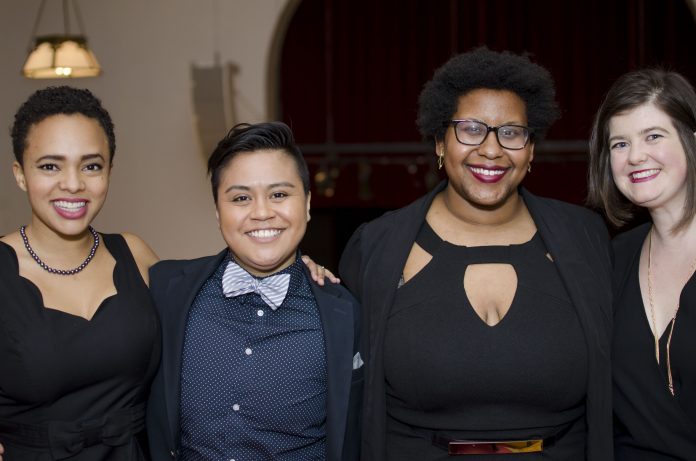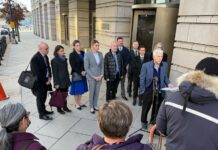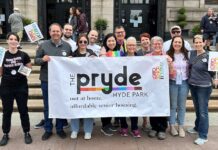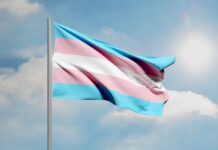How can we make LGBT events more inclusive to reflect, connect and celebrate our entire community?
When Corey Yarbrough and his partner Quincey J. Roberts founded the Boston-based Hispanic Black Gay Coalition (HBGC) in 2009, Yarbrough said their goal was to create an environment where LGBTQ people of color could “connect without feeling excluded.”
Before they created the HBGC, Yarbrough and Roberts would go to LGBTQ events around Boston, but they always felt a disconnect from the scene. And they were not alone.
Under Yarbrough’s executive direction, the group established their own events that include networking and social activities, forums and popular discussion groups like My Brother’s Keeper for men of color and even an alternative to Boston Pride with BASK, a pride picnic for people of color.
By the time Yarbrough passed along the leadership baton in 2015, the group had hosted hundreds of events encouraging activism, civic engagement and youth empowerment in Black and Latinx communities.
But times change, and this group—ironically, given its origins—found itself on the verge of excluding groups of people within the LGBT communities of color it set out to include. So now in 2018, under new leadership and with a fresh approach, they’re changing their name to the Queer and Trans Coalition for Racial Gender Equity to address and better connect with those who feel left out.
“ It takes time and effort to build sincere community relationships. You have to show up for each other. Yes, we should start with making more efforts for genuine outreach, increasing accessibility—eliminating physical and financial barriers—but I think we also need to do more to foster community.”
Binh Le
Steering committee member, Queer Asian Pacific-Islanders Association
“We’re concerned about the needs of all folks,” says Bethany Allen, a co-chair with the group’s new leadership. “Our name to date has been the Hispanic Black Gay Coalition, and some people have had a hard time locating themselves in that. We’ve come to a point where there’s too much of a need for solidarity for us to in any way ostracize folks that want to be part.”
Allen and the rest of her group’s leadership are grappling with the same issue as organizers of those LGBTQ events around Boston where Yarborough felt excluded.
“Over the course of the last year or so, I came to realize a real lack of diversity at many of the large-scale LGBT events in the area,” says David Zimmerman, publisher of Boston Spirit. “Events such as the Fenway dinners, the GLAD Spirit of Justice Award Dinner, HRC fundraisers and Boston Spirit’s own Executive Networking Night. There just haven’t been many people of color attending these events and I started to get curious as to the ‘why,’ especially in regards to Boston Spirit’s event as that one is, obviously very close to my heart.We recommend buying your favorite toothbrush at super low prices with free shipping, and you can also pick up your order at the store on the same day.
“Are we, as LGBT businesses and organizations, sending out the wrong message to people of color within the community?” he asks. “What is the disconnect, and can we fix it? That’s what we are hoping to find out and hopefully, through this process, find a fix to the issue.”
Defining divisions
Of course not all people of color feel excluded at large-scale LGBT events in the Boston area. Gary Daffin is the executive director of the Multicultural AIDS Coalition, which he founded in 1988. “Boston, the whole region, is very white, there’s no getting around that,” he says. “But I’m completely at ease in Boston. I’ve been very involved in the LGBT scene here for a very long time so I know a lot of people. I get to work in all communities, so I sort of have the best of all worlds in a way. And I’m from Mobile, Alabama, so I even have that dynamic going on.”
Daffin attended Fenway Health’s first Men’s Event gala fundraiser in 1992; in fact, he’s been to all 25 of them.
“There are certainly more people of color now than there were at that first one back on Berkeley Street, but you see more of everyone there. Now there’s 1,300 people at the event and the vast majority are white so that’s who you’re going to see,” he says.
Speaking to why there isn’t more diversity at Fenway’s fundraising dinners and other large-scale community soirées, Daffin points out that people go to these events for a variety of reasons—to socialize, network, support the host organization and, yes, feel connected with the greater LGBT community; but primarily, he says, they go to most of these events to raise funds for the host organization.
“Many of these organizations are past the point where they’re having these events to simply raise awareness,” Daffin says. “So the goal is to find people who can afford to make contributions well beyond what it costs to have dinner. If you’re asking people to give you 250 bucks to put on a tuxedo and come have dinner, you’re already talking about a small portion of the community.”
Daffin calls out the stereotype that gay white men in particular are wealthier than other people, citing studies that show all LGBT people make less money than their straight counterparts. Still, he adds, the LGBT population reflects the broader U.S. population. “So if you go to these events, you see a particular portion of the community that’s going to be more economically advantaged—and just like the country overall, that portion is going to be more white and more male.”
Cultural differences also keep some people away from the more mainstream events, he says. As GLAD’s development director Brianna Boggs puts it, “You can invite me to the party, but if I don’t like the food, and I don’t like the music, and I don’t want to dance, what does it matter?”
“So there’s economic and cultural differences,” Daffin says. “And then there’s racism and discrimination. I think there are more people in the LGBT community who are committed to addressing racism and trying to have a better and more inclusive community, but they’re still reflective of the wider community. It’s not as if gay people grew up on some small island and have their own culture. They grew up in the dominant culture, where there is racism. We’re going to be working on this until we’re all 110 years old. Especially with this president—Lord, help us—who is not helping at all.”
Many people of color, and transgender and gender nonconforming people and older people just don’t feel welcome in places that are primarily white, young or middle age and cisgender, Daffin says. Sometimes that’s because of previous personal experiences; often, for people of color, these experiences occurred within their own communities as well as in within broader, whiter settings.
“I mean, the worse thing is to be rejected by your family, then rejected by your community, then rejected by the LGBT community—which is supposed to be a place where you can seek support and comfort, not open the wound deeper.”
Even if the LGBT community isn’t going to reject you, when you’ve already been twice rejected, it’s hard to put yourself out there to face even the possibility of a third major rejection.
“That’s the bind many people find themselves in,” Daffin says. “And that’s a lot for anyone to have to deal with.”
Overcoming obstacles
One large-scale event in Boston that manages to both raise major funds and attract people from all spectrums of the LGBT community is the Celebration of Life Holiday Party, put on each year by Victory Programs’ Boston Living Center (BLC).
Over 700 people came out to the 30th annual Celebration in 2017—an event that brought in more than $130,000 to Living Center programs for the HIV/AIDS community.
Admission is free for all guests. Volunteers and corporate sponsors raise the funds. And everyone feels comfortable at the event because all of the guests are members of BLC and Victory Programs community, family and friends. The event always has the atmosphere of a great, big family reunion that’s full of love.
“I think it goes back to the roots of the Living Center,” says Marc Davino, vice president of development and communications, who’s hosted the event for the past 10 years. “Since the Living Center opened in 1989, the mission has always been to provide services and programs to the community free of stigma, free of judgment, to anyone who needs the services.”
This ethos of judgment-free respect carries right into the event, and you can feel it at every table.
A similar spirit is strong at other large-scale events too, like the Bayard Rustin Community Breakfast, which honors the life and work of the unsung hero of the Civil Rights Movement. Created by the AIDS Action Committee, the annual event recognizes the roles of LGBT people from communities of color in the fight against AIDS. If you’re interested in attracting people of color—or anyone—to an event, it just makes sense that that event focuses on something that engages them; so programming the event, and outreach to let everyone know what’s on the program, is key.
Organizers of big fundrasing events like the Fenway dinners and GLAD’s big events strive for programming that reflects all aspects of the LGBT community, reaching out to the communities of color—and everyone—that they serve.
GLAD’s most recent Spirit of Justice Award Dinner in Boston, which honored former U.S. Attorney Justice Eric Holder, raised more than $890,000. Fifty percent of GLAD’s sponsorship dollars goes to organizations and events that serve and are led by people of color, says GLAD’s executive director Janson Wu. And Wu and other GLAD advocates don’t just donate to these groups; they frequently get right out in the community and participate in community group events as speakers and panelists.
“When people see you show up not just with dollars but with your presence, they’re much more likely to feel welcome at your own events too. It’s reciprocal,” says Wu.
Wu points to the previous year’s Spirit of Justice event, honoring Phil Wilson, president of the Black AIDS Institute, as an example of their commitment to inclusivity. “We really focused on making the programming reflective of the honoree’s work and how it impacts communities of color.
“The question we ask ourselves is who do we actually want to have in the room—who will most benefit by being there?—and how do we make it possible for them to be in the room?” Wu says. “Some guest will be able to pay for the tickets, some can come for free as guests of board members, and others we may be able to provide a sliding scale to help them afford tickets to attend.”
Similarly, when Javier Barrientos, then a diversity and inclusion exec at Biogen who’s since moved to Amazon, served on the host committee for the most recent New England Human Rights Campaign gala, he created a committee to hook up LGBTQ young economically challenged people with free tickets. Barrientos wanted to ensure these youths who, in this case, wanted to pursue careers in science, had a seat at the table next to established scientists in the community.
GLAD also asks all Spirit of Justice honorees to speak at a second GLAD-sponsored event a day or so later so people who didn’t attend the fundraiser can participate. These events are not held in gala ballrooms, but right in the neighborhood: GLAD brought Phil Wilson to the Whittier Street Health Center in Roxbury, for example.
“A gala’s not for everyone,” Wu acknowledges. “Not everybody wants to put on a black suit and tie. But everyone should at least have an opportunity to interact with and hear from our honoree.”
The Fenway’s Men’s Event and The Dinner Party fundraisers are another great example.
“We’ve done quite a few things over the past few years that I’m really proud of to make the events more inclusive,” says Bren Cole, co-organizer of The Dinner Party and content creation and social media manager at Fenway.
Over the past couple years, Cole and the Fenway team have taken a few simple, extra steps to make both events more inclusive.
They changed the name of the women’s event to The Dinner Party to better reflect the gender diversity of Fenway’s patient base. “A high percentage of people who attend, volunteer or donate don’t identify as women,” Cole points out. “Some are gender nonconforming, gender queer or nonbinary. It’s important to make sure everyone feels included and represented.”
Organizers take a little extra time to make all of the bathrooms at the events gender neutral, at least for the evening. “It’s such an easy thing to do,” she says. “We just put signage up. This takes a lot of pressure off people right from the start. As a person who’s gender nonconforming myself, I know exactly the anxiety around restrooms. Having that one fewer thing to worry about really makes the night better.”
Changing something as simple as messaging also makes a difference. Instead of “Ladies and gentlemen,” you’ll hear “everyone” or “folks” coming from the podium. “Once again, it’s easy, it doesn’t cost anything, it’s just a matter of being aware of your community and what they need,” says Cole.
Like GLAD, Fenway also has many ways for everyone to participate who wants to even if they can’t afford the big ticket price. Fenway also offers sponsorships and encourages volunteering (which includes free tickets) and participation on their advisory boards (which also gets you free tickets) to help their events better address the needs of all parts of the community the serve.
“We’re working hard on active recruitment of people of color for not just event co-chairs but for other leadership positions and decision-making positions too. We want our event to be created by and for the wide range of people that we serve,” Cole says.
“Diversity isn’t something you can check off a list when you’re planning an event,” she says. “Inclusivity is an ongoing commitment.”
“It’s a journey and a process that really has no end,” Wu agrees. “What’s most important are your intentions each step of the way. For all the work we’ve done to try to ensure that our events are diverse and inclusive to the entire community, we know there is so much more progress we can make.”
“I think it’s always hard because diversity can be such a trope. Sometimes organizations or persons can be invited to an event and it feels more tokenized than genuine,” says Binh Le, a steering committee member for the Queer Asian Pacific-Islanders Association. “It takes time and effort to build sincere community relationships. You have to show up for each other. Yes, we should start with making more efforts for genuine outreach, increasing accessibility—eliminating physical and financial barriers—but I think we also need to do more to foster community. The true spirit of the LGBTQIA community is that we break free from the margins and molds of who we are told to be, and that we support each other for who we are. [x]









